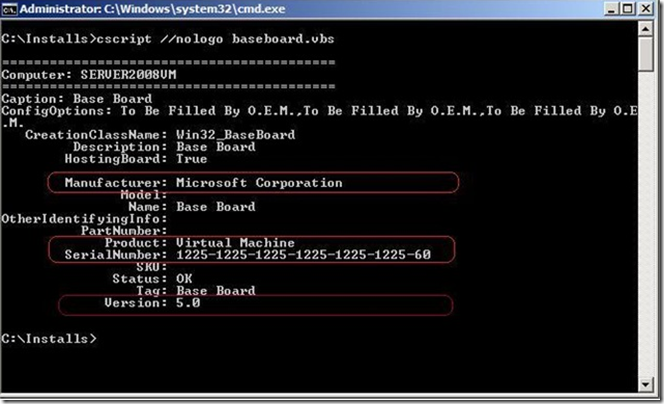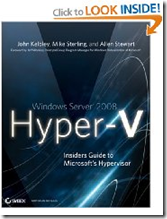Note
Access to this page requires authorization. You can try signing in or changing directories.
Access to this page requires authorization. You can try changing directories.
Sometimes, when troubleshooting or for forensic reasons, you may have to determine if an application is running inside a virtual machine. John Kelbley, co-author of Windows Server 2008 Hyper-V : Insiders Guide to Microsoft's Hypervisor, shares how.
One (relatively) simple way to detect key virtualization information is via WMI / WBEM. You can use the root\CIM2 namespace and access the Baseboard class (full of interesting BIOS information) to get a description of the "physical" system. This class often includes information about the motherboard and chassis - manufacture, model, serial number, other. You can run the following VBS to get this info.
On Error Resume Next
Const wbemFlagReturnImmediately = &h10
Const wbemFlagForwardOnly = &h20arrComputers = Array(".")
For Each strComputer In arrComputers
WScript.Echo
WScript.Echo "=========================================="
WScript.Echo "Computer: " & strComputer
WScript.Echo "=========================================="Set objWMIService = GetObject("winmgmts:\\" & strComputer & "\root\CIMV2")
Set colItems = objWMIService.ExecQuery("SELECT * FROM Win32_BaseBoard", "WQL", _
wbemFlagReturnImmediately + wbemFlagForwardOnly)For Each objItem In colItems
WScript.Echo "Caption: " & objItem.Caption
strConfigOptions = Join(objItem.ConfigOptions, ",")
WScript.Echo "ConfigOptions: " & strConfigOptions
WScript.Echo " CreationClassName: " & objItem.CreationClassName
WScript.Echo " Description: " & objItem.Description
WScript.Echo " HostingBoard: " & objItem.HostingBoard
WScript.Echo " InstallDate: " & WMIDateStringToDate(objItem.InstallDate)
WScript.Echo " Manufacturer: " & objItem.Manufacturer
WScript.Echo " Model: " & objItem.Model
WScript.Echo " Name: " & objItem.Name
WScript.Echo "OtherIdentifyingInfo: " & objItem.OtherIdentifyingInfo
WScript.Echo " PartNumber: " & objItem.PartNumber
WScript.Echo " Product: " & objItem.Product
WScript.Echo " SerialNumber: " & objItem.SerialNumber
WScript.Echo " SKU: " & objItem.SKU
WScript.Echo " Status: " & objItem.Status
WScript.Echo " Tag: " & objItem.Tag
WScript.Echo " Version: " & objItem.Version
WScript.Echo
Next
NextFunction WMIDateStringToDate(dtmDate)
WScript.Echo dtm:
WMIDateStringToDate = CDate(Mid(dtmDate, 5, 2) & "/" & _
Mid(dtmDate, 7, 2) & "/" & Left(dtmDate, 4) _
& " " & Mid (dtmDate, 9, 2) & ":" & Mid(dtmDate, 11, 2) & ":" & Mid(dtmDate,13, 2))
End Function
Here is a screen capture of the script results for a physical system running Windows Server 2008.
NOTE the motherboard was manufactured by Intel (model DG45ID).
Running the same script in a virtual machine returns similar information:
NOTE On the virtual machine, the "motherboard" appears to be made by Microsoft (we don't make motherboards!) and is of a virtual type.
The version number shown reflects the version of Hyper-V (Server 2008 RTM), and the Serial Number matches that found in the VM configuration file (XML file on the physical host).
The Perl script version for this is:
use strict;
use Win32::OLE('in');use constant wbemFlagReturnImmediately => 0x10;
use constant wbemFlagForwardOnly => 0x20;my @computers = (".");
foreach my $computer (@computers) {
print "\n";
print "==========================================\n";
print "Computer: $computer\n";
print "==========================================\n";my $objWMIService = Win32::OLE->GetObject("winmgmts:\\\\$computer\\root\\CIMV2") or die "WMI connection failed.\n";
my $colItems = $objWMIService->ExecQuery("SELECT * FROM Win32_BaseBoard", "WQL",
wbemFlagReturnImmediately | wbemFlagForwardOnly);foreach my $objItem (in $colItems) {
print " Caption: $objItem->{Caption}\n";
print " ConfigOptions: " . join(",", (in $objItem->{ConfigOptions})) . "\n";
print " CreationClassName: $objItem->{CreationClassName}\n";
print " Description: $objItem->{Description}\n";
print " HostingBoard: $objItem->{HostingBoard}\n";
print " InstallDate: $objItem->{InstallDate}\n";
print " Manufacturer: $objItem->{Manufacturer}\n";
print " Model: $objItem->{Model}\n";
print " Name: $objItem->{Name}\n";
print "OtherIdentifyingInfo: $objItem->{OtherIdentifyingInfo}\n";
print " Product: $objItem->{Product}\n";
print " SerialNumber: $objItem->{SerialNumber}\n";
print " SKU: $objItem->{SKU}\n";
print " Status: $objItem->{Status}\n";
print " Tag: $objItem->{Tag}\n";
print " Version: $objItem->{Version}\n";
print "\n";
}
}sub WMIDateStringToDate(strDate)
{
return "blah";
}
For additional reference, within Windows I could also access the same information in a single command line (in Windows XP or newer) by typing the following:
wmic baseboard get manufacturer, product, Serialnumber, version
For info on how to use Hper-V PS cmdlets see: https://www.microsoft.com/technet/scriptcenter/topics/msh/cmdlets/index.mspx
See also James O’Neil’s New and improved PowerShell Library for Hyper-V. Now with more functions and... documentation!
For 35 sample Hyper-V PS1 scripts in a zipfile, go to: Hyper-V%20PowerShell%20Example%20Scripts.zip-download
And buy John(et al)’s book!
Update: John's blogging now and has an updated method to detect the hypervisor: https://blogs.technet.com/enterprise_admin/archive/2009/10/20/detecting-the-virtualization-layer-from-within-a-guest-child-instance.aspx
Comments
- Anonymous
August 21, 2009
I wasn't super clear when I provided this information to Tony - this shows a VM running on a Microsoft virtualization layer like Hyper-V. A Windows virtual machine on VMWare does not report the same information (it may show that it has a 440BX chipset motherboard due to emulation). You can detect a VMware physical host by interrogating the WMI Win32_BIOS and looking at the serialnumber. My buddy Ben Herman (you know who you are you scripting master!) helped me with that since I didn't have a VMware host handy. I'll send Tony some more info on all this that he can post.



